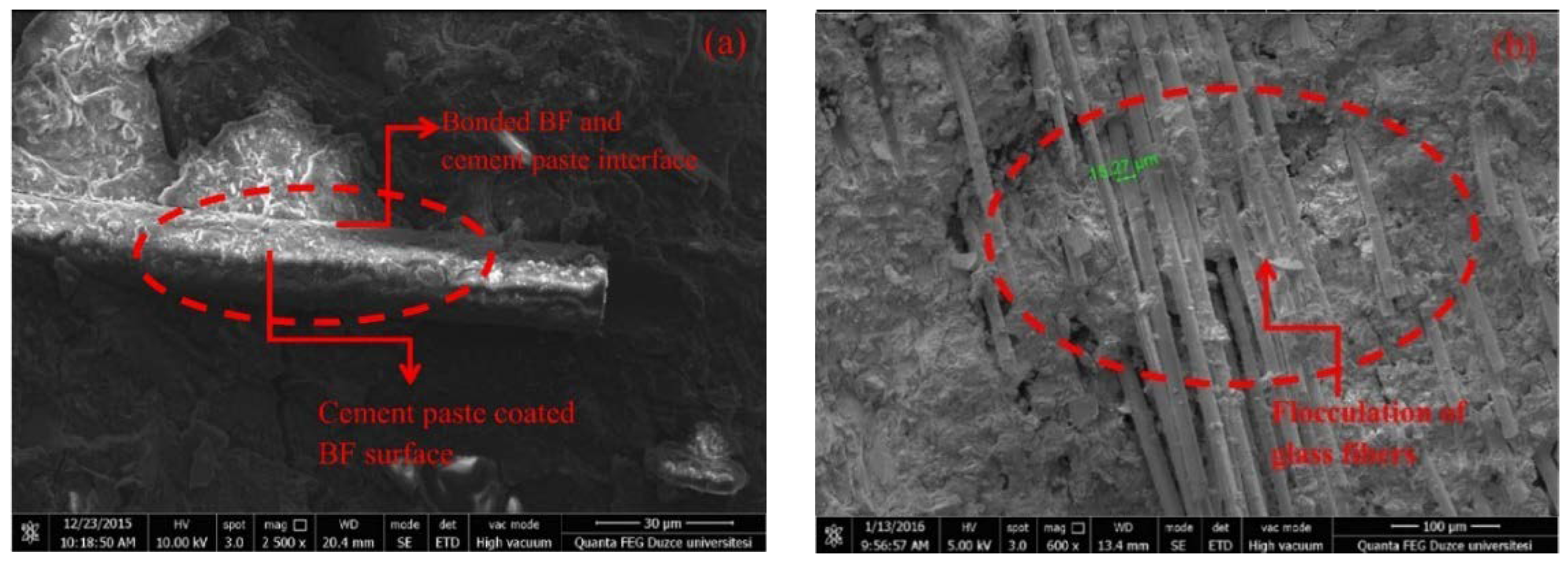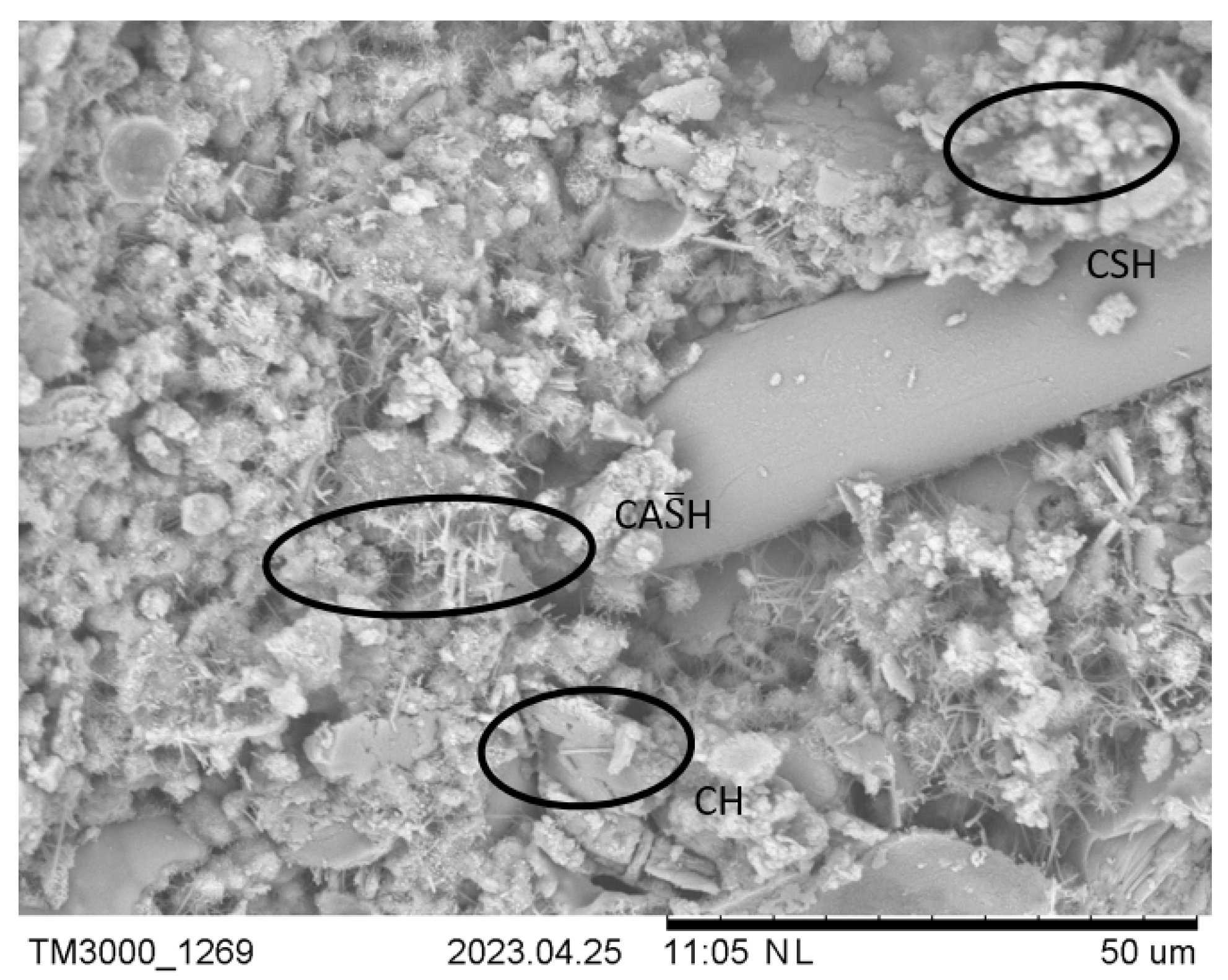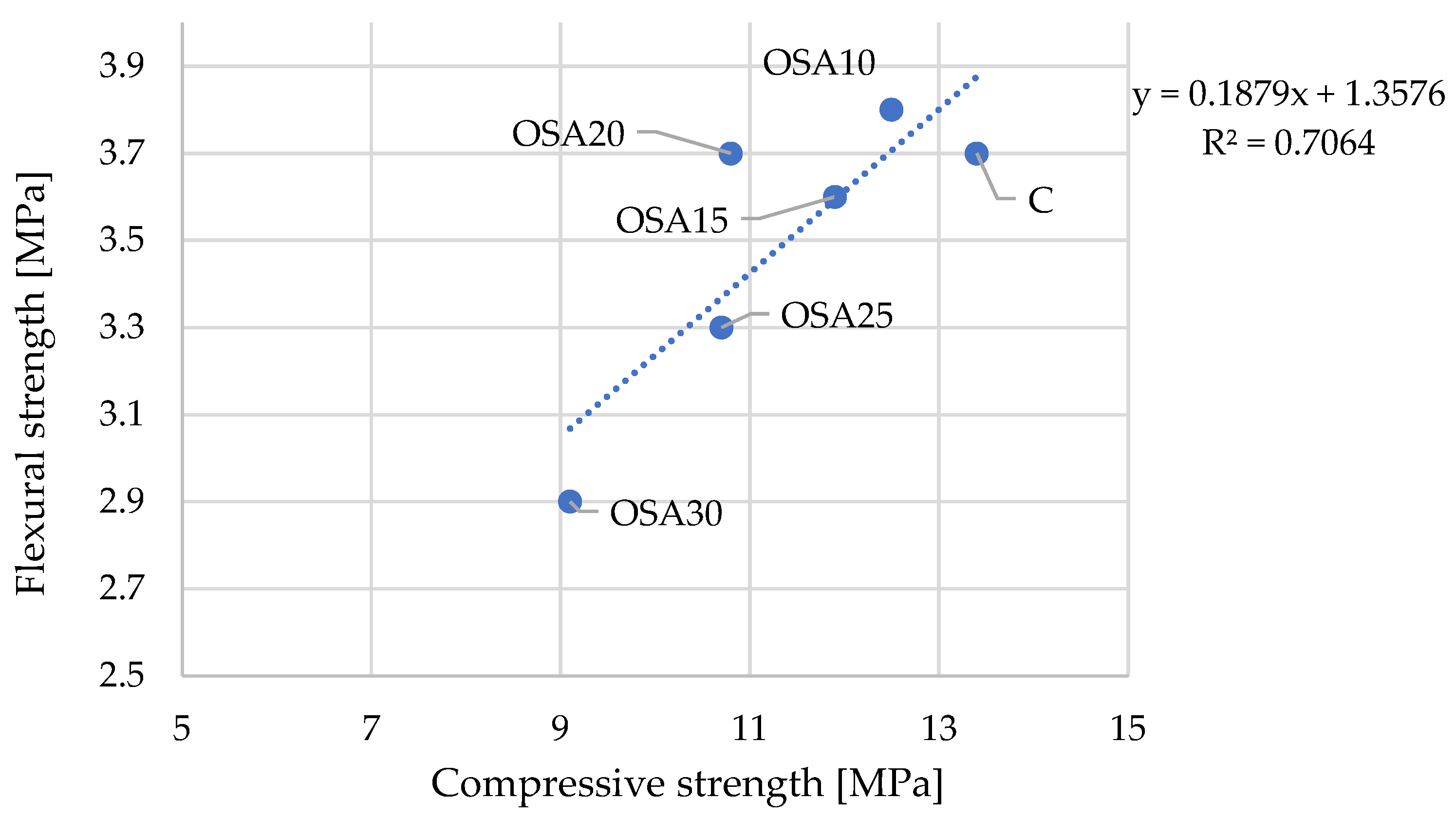Investigating the Influence of Oil Shale Ash and Basalt Composite Fibres on the Interfacial Transition Zone in Concrete
Abstract
:1. Introduction
1.1. Basalt Fibres
1.2. Interfacial Transition Zone (ITZ) of Concrete
1.3. Fibre–Paste Interfacial Transition Zone
1.4. Oil Shale Ash (OSA)
2. Methodology
3. Results and Discussion
3.1. Analysis of Fibre–Paste ITZ
3.2. Mechanical Properties of Concrete Mixtures
3.3. Environmental Benefits of Using OSA
4. Conclusions
- Considering the influence of OSA replacement:
- The presence of OSA reduces the EPD/carbon footprint of concrete composites.
- OSA replacement increases the presence of ettringite in fibre ITZs.
- Further testing of strength at higher ages, such as 56 and 90 days, is essential to establish the influence of OSA on concrete’s microstructure.
- Paste ITZs seem adequate for concrete with OSA at a dose of up to 10%. Higher percentages of replacement reduce the compressive strength and provide poor ITZs, with no expectation of additional delayed reactions between hydration products and the OSA.
- 2.
- Considering the presence of BFs in the mix:
- It has been observed that the coating of BFs becomes damaged during the mixing process, and individual basalt microfibres are directly in contact with the concrete matrix.
- The presence of a thin layer of CSH on the surface of BFs is a result of the alkaline exposure of BFs.
- Flexural strengths are relatively constant for mixes with up to 20% OSA replacement in the concrete mix.
- If the compressive strength is the decisive factor for concrete application, 10% OSA replacement in the mix is assessed as sufficient for the utilisation of BFs.
Author Contributions
Funding
Data Availability Statement
Conflicts of Interest
References
- Jhatial, A.A.; Nováková, I.; Gjerløw, E. A review on emerging cementitious materials, reactivity evaluation and treatment methods. Buildings 2023, 13, 526. [Google Scholar] [CrossRef]
- Scrivener, K.L.; Crumbie, A.K.; Laugesen, P. The interfacial transition zone (ITZ) between cement paste and aggregate in concrete. Interface Sci. 2004, 12, 411–421. [Google Scholar] [CrossRef]
- Meyyappan, P.L.; Carmichael, M.J. Studies on strength properties of basalt fibre reinforced concrete. Mater. Today Proc. 2021, 43, 2105–2108. [Google Scholar] [CrossRef]
- Mujalli, M.A.; Dirar, S.; Mushtaha, E.; Hussien, A.; Maksoud, A. Evaluation of the tensile characteristics and bond behaviour of steel fibre-reinforced concrete: An overview. Fibers 2022, 10, 104. [Google Scholar] [CrossRef]
- Deng, Y.; Zhang, Z.; Shi, C.; Wu, Z.; Zhang, C. Steel fiber–matrix interfacial bond in ultra-high performance concrete: A review. Engineering 2023, 22, 215–232. [Google Scholar] [CrossRef]
- Jhatial, A.A.; Goh, W.I.; Mastoi, A.K.; Traore, A.F.; Oad, M. Environmental assessment and mechanical properties of Polypropylene fibres reinforced ternary binder foamed concrete. Environ. Sci. Pollut. Res. 2021, 29, 2985–3007. [Google Scholar] [CrossRef]
- Al-Kharabsheh, B.N.; Arbili, M.M.; Majdi, A.; Alogla, S.M.; Hakamy, A.; Ahmad, J.; Deifalla, A.F. Basalt fiber reinforced concrete: A compressive review on durability aspects. Materials 2023, 16, 429. [Google Scholar] [CrossRef] [PubMed]
- Wang, X.H.; Jacobsen, S.; He, J.Y.; Zhang, Z.L.; Lee, S.F.; Lein, H.L. Application of nanoindentation testing to study of the interfacial transition zone in steel fiber reinforced mortar. Cem. Concr. Res. 2009, 39, 701–715. [Google Scholar] [CrossRef]
- Mehdipour, I.; Khayat, K.H. Effect of particle-size distribution and specific surface area of different binder systems on packing density and flow characteristics of cement paste. Cem. Concr. Compos. 2017, 78, 120–131. [Google Scholar] [CrossRef]
- Anas, M.; Khan, M.; Bilal, H.; Jadoon, S.; Khan, M.N. Fiber reinforced concrete: A review. Eng. Proc. 2022, 22, 3. [Google Scholar] [CrossRef]
- Monaldo, E.; Nerilli, F.; Vairo, G. Basalt-based fiber-reinforced materials and structural applications in civil engineering. Compos. Struct. 2019, 214, 246–263. [Google Scholar] [CrossRef]
- Ramesh, B.; Eswari, S. Mechanical behaviour of basalt fibre reinforced concrete: An experimental study. Mater. Today Proc. 2021, 43, 2317–2322. [Google Scholar] [CrossRef]
- Katrien, B.; Greet, J.; Saskia, M. Summary Report on the Environmental Potential of Basalt Fibres Versus Glass Fibres; 2017/SMAT/R/1256; Basaltex NV: Wevelgem, Belgium, 2017. [Google Scholar]
- Ramakrishnan, V.; Tolmare, N.S.; Brik, V.B. Performance evaluation of 3-D basalt fiber reinforced concrete & basalt rod reinforced concrete. In Final Report for Highway IDEA Project 45; Transportation Research Board: Washington, DC, USA, 1998. [Google Scholar]
- Biradar, S.V.; Dileep, M.S.; Vijaya Gowri, D.T. Studies of concrete mechanical properties with basalt fibers. IOP Conf. Ser. Mater. Sci. Eng. 2020, 1006, 012031. [Google Scholar] [CrossRef]
- Arslan, M.E. Effects of basalt and glass chopped fibers addition on fracture energy and mechanical properties of ordinary concrete: CMOD measurement. Constr. Build. Mater. 2016, 114, 383–391. [Google Scholar] [CrossRef]
- Branston, J.; Das, S.; Kenno, S.Y.; Taylor, C. Mechanical behaviour of basalt fibre reinforced concrete. Constr. Build. Mater. 2016, 124, 878–886. [Google Scholar] [CrossRef]
- Szczesniak, M.; Rougelot, T.; Burlion, N.; Shao, J.-F. Compressive strength of cement-based composites: Roles of aggregate diameter and water saturation degree. Cem. Concr. Compos. 2013, 37, 249–258. [Google Scholar] [CrossRef]
- Wong, H.S.; Zobel, M.; Buenfeld, N.R.; Zimmerman, R.W. Influence of the interfacial transition zone and microcracking on the diffusivity, permeability and sorptivity of cement-based materials after drying. Mag. Concr. Res. 2009, 61, 571–589. [Google Scholar] [CrossRef]
- Hilal, A.A. Microstructure of concrete. In High Performance Concrete Technology and Applications; Yilmaz, S., Ozmen, H.B., Eds.; IntechOpen: Rijeka, Croatia, 2016; Chapter 1. [Google Scholar] [CrossRef]
- Hashin, Z.; Monteiro, P.J.M. An inverse method to determine the elastic properties of the interphase between the aggregate and the cement paste. Cem. Concr. Res. 2002, 32, 1291–1300. [Google Scholar] [CrossRef]
- Jhatial, A.A.; Goh, W.I.; Mohamad, N.; Rind, T.A.; Sandhu, A.R. Development of thermal insulating lightweight foamed concrete reinforced with polypropylene fibres. Arab. J. Sci. Eng. 2020, 45, 4067–4076. [Google Scholar] [CrossRef]
- Voutetaki, M.E.; Naoum, M.C.; Papadopoulos, N.A.; Chalioris, C.E. Cracking diagnosis in fiber-reinforced concrete with synthetic fibers using piezoelectric transducers. Fibers 2022, 10, 5. [Google Scholar] [CrossRef]
- Chan, Y.-W.; Chu, S.-H. Effect of silica fume on steel fiber bond characteristics in reactive powder concrete. Cem. Concr. Res. 2004, 34, 1167–1172. [Google Scholar] [CrossRef]
- He, S.; Yang, E.-H. Strategic strengthening of the interfacial transition zone (ITZ) between microfiber and cement paste matrix with carbon nanofibers (CNFs). Cem. Concr. Compos. 2021, 119, 104019. [Google Scholar] [CrossRef]
- Liu, J.; Farzadnia, N.; Shi, C. Effects of superabsorbent polymer on interfacial transition zone and mechanical properties of ultra-high performance concrete. Constr. Build. Mater. 2020, 231, 117142. [Google Scholar] [CrossRef]
- Teixeira, R.S.; Tonoli, G.H.D.; Santos, S.F.; Rayón, E.; Amigó, V.; Savastano, H., Jr.; Rocco Lahr, F.A. Nanoindentation study of the interfacial zone between cellulose fiber and cement matrix in extruded composites. Cem. Concr. Compos. 2018, 85, 1–8. [Google Scholar] [CrossRef]
- Bentur, A.; Mindess, S. Fibre Reinforced Cementitious Composites, 2nd ed.; Taylor & Francis Group: London, UK; New York, NY, USA, 2006; ISBN 0-203-08872-7 (ebk). [Google Scholar]
- Li, V.C.; Stang, H. Interface property characterization and strengthening mechanisms in fiber reinforced cement based composites. Adv. Cem. Based Mater. 1997, 6, 1–20. [Google Scholar] [CrossRef]
- Abdallah, S.; Fan, M.; Rees, D.W.A. Bonding mechanisms and strength of steel fiber–reinforced cementitious composites: Overview. J. Mater. Civ. Eng. 2018, 30, 04018001. [Google Scholar] [CrossRef]
- Alanazi, H. Study of the interfacial transition zone characteristics of geopolymer and conventional concretes. Gels 2022, 8, 105. [Google Scholar] [CrossRef] [PubMed]
- Adamson, J.; Irha, N.; Adamson, K.; Steinnes, E.; Kirso, U. Effect of oil shale ash application on leaching behavior of arable soils: An experimental study. Oil Shale 2010, 27, 250. [Google Scholar] [CrossRef]
- Alaloul, W.S.; Al Salaheen, M.; Malkawi, A.B.; Alzubi, K.; Al-Sabaeei, A.M.; Ali Musarat, M. Utilizing of oil shale ash as a construction material: A systematic review. Constr. Build. Mater. 2021, 299, 123844. [Google Scholar] [CrossRef]
- Energia, E. Oil Shale Ash. 2023. Available online: https://www.energia.ee/en/ari/toostuslahendused/tuhk (accessed on 14 July 2023).
- Available online: https://www.ragnsells.com/about-us/press-media/articles/oil-shale-ash-in-estonia/ (accessed on 12 June 2024).
- Liu, J.; Qiu, J.; Wu, P.; Sun, X.; Zhang, S.; Guo, Z. Calcined oil shale residue as a supplementary cementitious material for ordinary Portland cement. Constr. Build. Mater. 2021, 306, 124849. [Google Scholar] [CrossRef]
- Ashteyat, A.M.; Al Rjoub, Y.S.; Obaidat, A.T.; Kirgiz, M.; Abdel-Jaber, M.; Smadi, A. Roller compacted concrete with oil shale ash as a replacement of cement: Mechanical and durability behavior. Int. J. Pavement Res. Technol. 2022, 17, 151–168. [Google Scholar] [CrossRef]
- Murad, Y.Z.; Tarawneh, A.; Saleh, E.F.; Musmar, M.; AlMashaqbeh, A.; Alfaouti, Q.T.; Aljaafreh, A.J. Mechanical properties of heat damaged oil shale ash concrete. Innov. Infrastruct. Solut. 2023, 8, 23. [Google Scholar] [CrossRef]
- Kalpokaitė-Dičkuvienė, R.; Pitak, I.; Baltušnikas, A.; Čėsnienė, J.; Kriūkienė, R.; Lukošiūtė, S.I. Functional and microstructural alterations in hydrated and freeze-thawed cement-oil shale ash composites. Case Stud. Constr. Mater. 2023, 19, e02302. [Google Scholar] [CrossRef]
- ASTM. ASTM C618-22 Standard Specification for Coal Fly Ash and Raw or Calcined Natural Pozzolan for Use in Concrete; ASTM International: West Conshohocken, PA, USA, 2022. [Google Scholar]
- Deutsche Basalt Faser. Turbobuild Integral. Available online: https://deutsche-basalt-faser.de/en/products/turbobuild-integral/ (accessed on 14 July 2023).
- Medina, C.; Zhu, W.; Howind, T.; Sánchez de Rojas, M.I.; Frías, M. Influence of interfacial transition zone on engineering properties of the concrete manufactured with recycled ceramic aggregate. J. Civil. Eng. Manag. 2014, 21, 83–93. [Google Scholar] [CrossRef]
- CEN. EN 450-1 Fly Ash for Concrete—Definition, Specifications and Conformity Criteria; European Committee for Standardization (CEN): Brussels, Belgium, 2012. [Google Scholar]
- Suraneni, P.; Burris, L.; Shearer, C.R.; Hooton, R.D. ASTM C618 fly ash specification: Comparison with other specifications, shortcomings, and solutions. ACI Mater. J. 2021, 118, 157–167. [Google Scholar] [CrossRef]
- Colombo, A.; Geiker, M.; Justnes, H.; Lauten, R.A.; De Weerdt, K. The effect of calcium lignosulfonate on ettringite formation in cement paste. Cem. Concr. Res. 2018, 107, 188–205. [Google Scholar] [CrossRef]
- Lin, C.; Kanstad, T.; Jacobsen, S.; Ji, G. Bonding property between fiber and cementitious matrix: A critical review. Constr. Build. Mater. 2023, 378, 131169. [Google Scholar] [CrossRef]
- Khandelwal, S.; Rhee, K.Y. Recent advances in basalt-fiber-reinforced composites: Tailoring the fiber-matrix interface. Compos. B Eng. 2020, 192, 108011. [Google Scholar] [CrossRef]
- Mahltig, B. Basalt fibers. In Inorganic and Composite Fibers; Elsevier: Amsterdam, The Netherlands, 2018; pp. 195–217. [Google Scholar] [CrossRef]
- Fiore, V.; Scalici, T.; Di Bella, G.; Valenza, A. A review on basalt fibre and its composites. Compos. B Eng. 2015, 74, 74–94. [Google Scholar] [CrossRef]
- Wei, C.; Zhou, Q.; Deng, K.; Lin, Y.; Wang, L.; Luo, Y.; Zhang, Y.; Zhou, H. Alkali resistance prediction and degradation mechanism of basalt fiber: Integrated with artificial neural network machine learning model. J. Build. Eng. 2024, 86, 108850. [Google Scholar] [CrossRef]
- Available online: www.lca.no (accessed on 16 April 2024).










| Oxides | SiO2 | Al2O3 | Fe2O3 | TiO2 | CaO | MgO | Na2O | K2O | MnO | SO3 | P2O5 | LOI * |
|---|---|---|---|---|---|---|---|---|---|---|---|---|
| OSA | 33.20 | 8.09 | 4.44 | 0.53 | 37.06 | 3.07 | 0.26 | 3.84 | 0.05 | 5.45 | 0.16 | 3.85 |
| PLC | 19.11 | 4.79 | 2.85 | 0.33 | 61.69 | 3.17 | 0.08 | 1.99 | 0.12 | 2.02 | 0.51 | 2.61 |
| Mix | PLC (kg) | OSA (kg) | DP (kg) | MS (kg) | Aggregates (kg) | Water (kg) | SP (kg) | Fibre (kg) | ||
|---|---|---|---|---|---|---|---|---|---|---|
| 0–1.0 mm | 0.3–2.5 mm | 4–8 mm | ||||||||
| C | 250.0 | 0.0 | 218.2 | 13.6 | 572.7 | 954.6 | 54.6 | 227.3 | 6.36 | 8.0 |
| OSA10 | 225.0 | 25.0 | 218.2 | 13.6 | 572.7 | 954.6 | 54.6 | 227.3 | 6.36 | 8.0 |
| OSA15 | 212.5 | 37.5 | 218.2 | 13.6 | 572.7 | 954.6 | 54.6 | 227.3 | 6.36 | 8.0 |
| OSA20 | 200.0 | 50.0 | 218.2 | 13.6 | 572.7 | 954.6 | 54.6 | 227.3 | 6.36 | 8.0 |
| OSA25 | 187.5 | 62.5 | 218.2 | 13.6 | 572.7 | 954.6 | 54.6 | 227.3 | 6.36 | 8.0 |
| OSA30 | 175.0 | 75.0 | 218.2 | 13.6 | 572.7 | 954.6 | 54.6 | 227.3 | 6.36 | 8.0 |
| Mix | Slump (mm) | Compressive Strength (MPa) | Flexural Strength (MPa) |
|---|---|---|---|
| C | 225 | 13.4 | 3.7 |
| OSA10 | 230 | 12.5 | 3.8 |
| OSA15 | 220 | 11.9 | 3.6 |
| OSA20 | 180 | 10.8 | 3.7 |
| OSA25 | 220 | 10.7 | 3.3 |
| OSA30 | 230 | 9.1 | 2.9 |
Disclaimer/Publisher’s Note: The statements, opinions and data contained in all publications are solely those of the individual author(s) and contributor(s) and not of MDPI and/or the editor(s). MDPI and/or the editor(s) disclaim responsibility for any injury to people or property resulting from any ideas, methods, instructions or products referred to in the content. |
© 2024 by the authors. Licensee MDPI, Basel, Switzerland. This article is an open access article distributed under the terms and conditions of the Creative Commons Attribution (CC BY) license (https://creativecommons.org/licenses/by/4.0/).
Share and Cite
Nováková, I.; Jhatial, A.A.; Kekez, S.; Gjerløw, E.; Gulik, V.; Kannathasan, K.R.; Vaišnoras, M.; Krasnikovs, A. Investigating the Influence of Oil Shale Ash and Basalt Composite Fibres on the Interfacial Transition Zone in Concrete. Buildings 2024, 14, 1952. https://doi.org/10.3390/buildings14071952
Nováková I, Jhatial AA, Kekez S, Gjerløw E, Gulik V, Kannathasan KR, Vaišnoras M, Krasnikovs A. Investigating the Influence of Oil Shale Ash and Basalt Composite Fibres on the Interfacial Transition Zone in Concrete. Buildings. 2024; 14(7):1952. https://doi.org/10.3390/buildings14071952
Chicago/Turabian StyleNováková, Iveta, Ashfaque Ahmed Jhatial, Sofija Kekez, Eirik Gjerløw, Volodymyr Gulik, Karunamoorthy Rengasamy Kannathasan, Mindaugas Vaišnoras, and Andrejs Krasnikovs. 2024. "Investigating the Influence of Oil Shale Ash and Basalt Composite Fibres on the Interfacial Transition Zone in Concrete" Buildings 14, no. 7: 1952. https://doi.org/10.3390/buildings14071952






